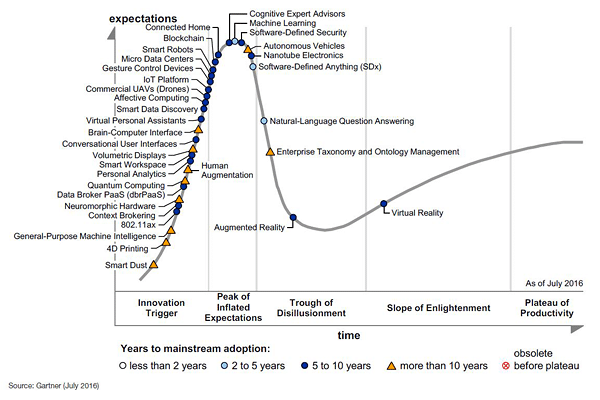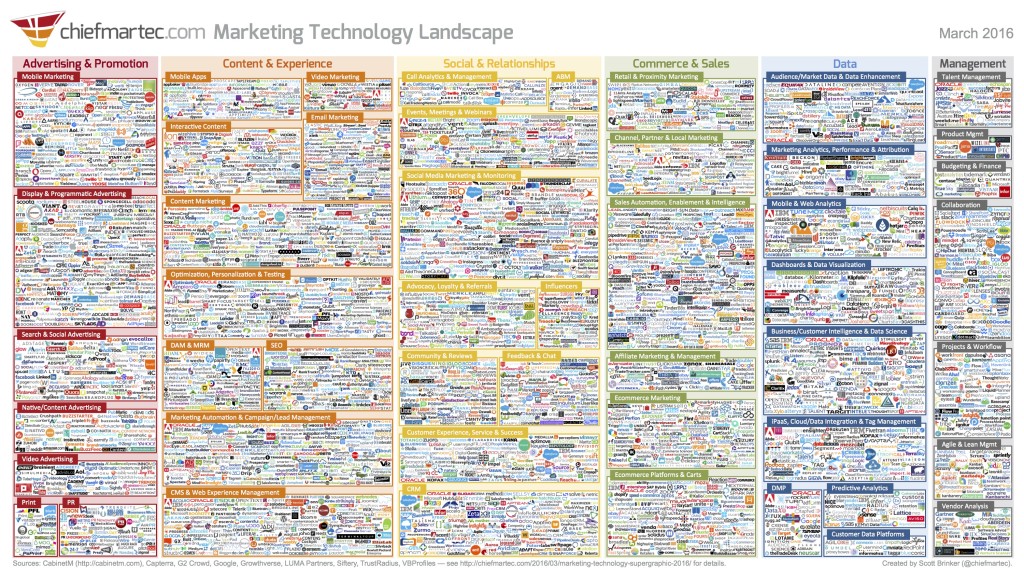Gartner Hype Cycle for Emerging Technologies 2016
Perhaps more so than ever before, the 2016 Gartner Hype Cycle for Emerging Technologies zeroes in on big data applications and where they are in the eyes of the market.
Let’s first start by taking a look at this year’s edition of the Gartner Hype Cycle for Emerging Technologies:

We have discussed what the Hype Cycle means and how to read it in the past, so in this case, we’re simply going to focus on what the trends indicate and what we can expect to see in this space in the coming year, largely from a marketing perspective.
Augmented Reality: Poised for a Boom
Augmented reality has long been headed towards the Trough of Disillusionment. While the concept has been interesting for quite some time, universal and practical applications for the existing technology have not really existed.
Enter Pokémon GO.
The Hype Cycle might show augmented reality in the Trough, though it is likely a little closer than 5 to 10 years from mainstream adoption based on the speed with which an existing AR platform swept the public. Now, of course, hype and nostalgia had a lot to do with it, but it is still telling of how much closer we are than we might have once believed. There is clearly a market for functional AR, and we can expect to see marketers, developers and brands both large and small trying to capitalize on this reality (moving AR into the Slope of Enlightenment sooner than expected, maybe even passing Virtual Reality in that timeframe).
The Singularity Cometh
“One cubic inch of nanotube circuitry, once fully developed, would be up to one hundred million times more powerful than the human brain,” Ray Kurzweil wrote in The Singularity is Near: When Humans Transcend Biology. If we look at the Innovation Trigger on the Cycle and follow that through the Peak of Inflated Expectations, we can see that this statement is on the verge of becoming a reality.
The use of data, machine learning and deep neural networks is what makes up so much of the 2016 Hype Cycle, and while it might be over a decade before much of what is in the works becomes commonplace, the point here is that it is all in the works.
Machine learning is already marked as 2 to 5 years away, despite the fact that it sits atop the Peak of Inflated Expectations. That is largely because its applications can really only be refined and developed further once a breakthrough is made. So the transition through the Trough of Disillusionment will be rather quick (comparatively speaking). Another reason for that is the accessibility (as compared to more cost-prohibitive developments, such as virtual reality). Machine learning and neural networks are slowly making their way into everyday items thanks to open sourced code and technology. This will mean a very subtle but profound technological revolution will arrive in a very short period of time.
A Business Shift
Lastly, a major paradigm shift comes in the form of the workspace. We recently discussed how there were more marketing technologies than ever after ChiefMarTec.com released its annual Marketing Technology Landscape Supergraphic (shown below).

While we are more than likely to see consolidation in most (if not all) of these spaces, we will likely also see a budding new marketplace for friendly business and marketing tech. What do we mean by that? In essence, a move away from the competitive nature of technology landscapes and into a more cohesive network will lead to changing strategies for both the marketers and the tech companies. It’ll be interesting to watch that shift unfold.
Conclusion
Again, there is a lot on the horizon, but much of what is listed in this Hype Cycle seems quite a ways off (even more so than usual). That said, the speed of transformation is at an all time high, so we can be all but certain that while these emerging technologies may seem like a ways off, they will be a part of mainstream applications before we know it.



